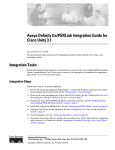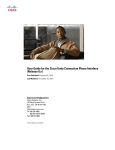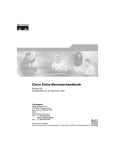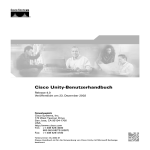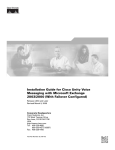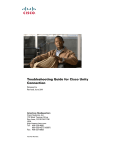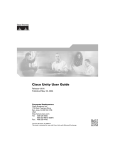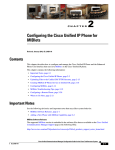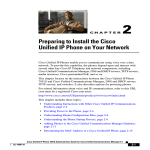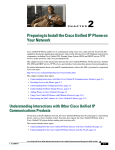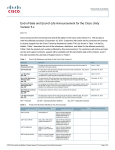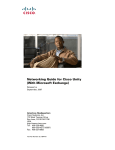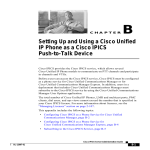Download Cisco Systems OL-13207-01 User's Manual
Transcript
CH A P T E R 5 Operator and Support Desk Orientation Operators in your organization need information about Cisco Unity Connection that is specific to your installation. In addition, if your organization has a support desk, the staff will need to be prepared to answer the questions that users may ask, and to be aware of the resources that are available to assist them in answering user questions. See the following sections: • Operator Orientation, page 5-1 • Support Desk Orientation, page 5-2 Operator Orientation Operator orientation should address the same points as user orientation, but in greater detail. Operators must be familiar with how users use Cisco Unity Connection. Depending on the size of your organization, the operator may be the person users are likely to ask when they have questions about Connection. In addition to the information in the “User Orientation” chapter and the “Support Desk Orientation” section on page 5-2 (as applicable), operators also need to understand the following concepts and tasks. Roles of the Operator and the Automated Attendant The way your organization uses the automated attendant determines what the operator responsibilities are. The automated attendant is a call handler that is used in place of a human operator to answer and direct calls by playing greetings and responding to touchtones. The automated attendant can provide a menu of options (for example, “For Sales, press 1; for Service, press 2.”), and it can also provide information (for example, “Our normal business hours are Monday through Friday, 8 a.m. to 5 p.m.”). Directing Calls Regardless of how your organization uses the automated attendant, many calls will go to the operator. The operator must know how to direct calls to voice mail and to user phones. With Cisco Unified Communications Manager (CM) (formerly known as Cisco Unified CallManager), you can program the phone to direct calls to voice mail. For details on setting this up, see the tech note How to Transfer a Caller Directly into a Mailbox, available at http://www.cisco.com/en/US/products/sw/voicesw/ps2237/prod_tech_notes_list.html. Forwarding Messages to Intended Recipients If an operator also owns a call handler or system distribution list, make sure that the operator knows to review messages frequently, and to forward messages as necessary to the applicable recipient(s). User Workstation Setup Guide for Cisco Unity Connection Release 2.x OL-13207-01 5-1 Chapter 5 Operator and Support Desk Orientation Support Desk Orientation Using the Cisco Unity Greetings Administrator An operator who is responsible for changing call handler greetings for the organization can use the Cisco Unity Greetings Administrator when it is not practical to change a greeting in Cisco Unity Connection Administration. For example, if the office is unexpectedly closed because of bad weather, the operator can call from home to use the Cisco Unity Greetings Administrator to enable the alternate Opening Greeting, or to rerecord a call handler greeting stating that the office is closed. For information on using the Cisco Unity Greetings Administrator, see the System Administration Guide for Cisco Unity Connection, at http://www.cisco.com/en/US/products/ps6509/prod_maintenance_guides_list.html. Using the Cisco Unity Broadcast Message Administrator If an operator will be responsible for sending recorded announcements to everyone in an organization (or to particular location(s) within an organization), explain how to access and use the Cisco Unity Broadcast Message Administrator to send broadcast messages. For information on using the Cisco Unity Broadcast Message Administrator, see the System Administration Guide for Cisco Unity Connection, at http://www.cisco.com/en/US/products/ps6509/prod_maintenance_guides_list.html. Support Desk Orientation Support desk orientation should address the same points as user and operator orientation, but in greater detail. Support desk staff must be familiar with how users and operators use Cisco Unity Connection, and the common problems that users may encounter when using Connection. Instead of using the Connection server, it may be helpful to set up a test server that support desk staff can use to browse to Cisco Unity Connection Administration, and troubleshoot and test client applications. To prepare for possible calls to the support desk at your organization, familiarize the support desk staff with the resources listed in the “Support Desk Resources” section below, and with the potential user concerns and misconceptions listed in the “Potential User Concerns and Misconceptions” section on page 5-3. (See also the“Operator Orientation” section on page 5-1 and the “User Orientation” chapter.) Support Desk Resources • User documentation is available at http://www.cisco.com/en/US/products/ps6509/products_user_guide_list.html. In particular, support desk staff may find the Cisco Unity Connection at a Glance documents helpful in gaining a high-level visual understanding of the flow of the Connection conversation. • The Compatibility Matrix: Cisco Unity Connection and the Software on User Workstations is available at http://www.cisco.com/en/US/products/ps6509/products_device_support_tables_list.html. • The following chapters in this guide provide information on how user workstations should be set up, and describes how users use Connection client applications: – Setting Up Access to the Cisco Personal Communications Assistant – Setting Up Playback and Recording Devices for the Media Master – Configuring an E-Mail Account to Access Cisco Unity Connection Voice Messages • The Troubleshooting Guide for Cisco Unity Connection is available at http://www.cisco.com/en/US/products/ps6509/prod_troubleshooting_guides_list.html. User Workstation Setup Guide for Cisco Unity Connection Release 2.x 5-2 OL-13207-01 Chapter 5 Operator and Support Desk Orientation Support Desk Orientation • For descriptions and the URLs of all Connection documentation on Cisco.com, see the Documentation Guide for Cisco Unity Connection. The document is shipped with Connection and is available at http://www.cisco.com/en/US/products/ps6509/products_documentation_roadmaps_list.html. Potential User Concerns and Misconceptions Table 5-1 describes potential user issues, which are typically based on misconceptions about how Cisco Unity Connection works. Users who encounter such issues are often those who are accustomed to another voice messaging system, have not yet completed Connection training, or are unaware of a new feature or functionality change to an existing system. Table 5-1 Potential User Concerns and Misconceptions Potential Issue Description Delayed messages Users may believe that their messages are delayed for the following reasons: Deleted messages • While listening to new messages, users may skip a message and inadvertently mark it new. Later, when they check messages again, they hear the skipped message and believe that the message arrived after a delay. • Users may skip more messages than they intend while listening to their messages, and later check messages again only to hear one or more of the skipped messages, and believe that the message(s) arrived after a delay. • While listening to messages, other new messages arrive that users may not be aware of. Later, when they check messages again, they hear the new message(s) and believe that they were delayed. By default, when users delete a new or saved message, Cisco Unity Connection does not ask them to confirm the deletion. You may want to enable Connection to request confirmation from users before proceeding with the deletion, especially if many users do not belong to a class of service that allows them to retain and review their deleted messages. You can set up Connection to confirm deletion of messages on the System Settings > Advanced > Conversations page in Cisco Unity Connection Administration. For information on deleted messages, refer users to the “Deleting Messages” chapter of the User Guide for Cisco Unity Connection, available at http://www.cisco.com/en/US/products/ps6509/products_user_guide_list.html. User Workstation Setup Guide for Cisco Unity Connection Release 2.x OL-13207-01 5-3 Chapter 5 Operator and Support Desk Orientation Support Desk Orientation Table 5-1 Potential User Concerns and Misconceptions (continued) Potential Issue Description Deleted messages: IMAP and MAPI behavior When users access messages stored on a Microsoft Exchange server both from a Microsoft Outlook client and from Cisco Unity Connection, they may experience unexpected and confusing behavior when deleting messages. The difference in behavior occurs when the Microsoft Outlook client is configured to use MAPI, the Microsoft interface for connecting to Exchange, and stems from the fact that MAPI and IMAP—the protocol used by Connection—use different mechanisms for marking messages as deleted. If you have users who access a Microsoft Exchange server by using Outlook (with MAPI) or Outlook Web Access, and who also use Connection to manage messages on the same message store, be sure to alert them to this behavior. Deleted Messages—IMAP Behavior When a user deletes a message from Microsoft Outlook, the message is moved from the Inbox to the Deleted Items folder. At this point, Connection can no longer access the message, and will no longer indicate that the message exists either as a new, saved, or deleted message. Deleted Messages—MAPI Behavior When a user deletes a message from Connection, the message remains in the Inbox but is flagged to indicate that it has been marked deleted by the user. However, when configured to use MAPI, Microsoft Outlook does not recognize this flag as a deletion, and will continue to display the message as a new or saved message in the Inbox. Directory listing: users are not listed as expected When users do not have a recorded name, they are not listed in the phone directory and as a result, outside callers are not be able to find them when searching for them by name. By default, Cisco Unity Connection prompts users to record a name during first-time enrollment, but it does not prevent them from completing the enrollment process if they do not. To address this issue, consider the following options: • You can change whether recording a name is required to complete first-time enrollment on the System Settings > Advanced > Conversations page in Cisco Unity Connection Administration. • You can provide recorded names for users in Cisco Unity Connection Administration. • Users with class of service rights can record their own names by using the Connection conversation or the Cisco Unity Assistant. Note This problem does not occur for internal users, but only for outside callers; Cisco Unity Connection users who address messages by name will still be able to find other users even if they have not recorded a voice name. User Workstation Setup Guide for Cisco Unity Connection Release 2.x 5-4 OL-13207-01 Chapter 5 Operator and Support Desk Orientation Support Desk Orientation Table 5-1 Potential User Concerns and Misconceptions (continued) Potential Issue Description IMAP client: Differences in client behavior Users who use different third-party IMAP clients to access voice messages from their desktop machines may note the following discrepancies in behavior: • Microsoft Outlook client: – For new messages, the “Mark as Unread” feature will mark messages as new on the Cisco Unity Connection server, regardless of whether the WAV file message attachment is downloaded or not. – Voice messages that are deleted over the phone are marked for deletion in the Outlook client and are changed to strikethrough text when users select the “Send/Receive” command. • Novell GroupWise client: – When new messages with the WAV file message attachment have been downloaded to the GroupWise client, the “Read Later” feature no longer marks the message as new on the Connection server. – Voice messages that are deleted over the phone are not marked for deletion in GroupWise; users will need to manually delete them from this client. – GroupWise users will need to use the “Send/Retrieve” command to update message status from the Connection server. Mailbox fills up quickly Users may complain that their mailboxes are filling up too quickly, for any of the following reasons: • Cisco Unity Connection does not automatically delete messages when they reach a certain age. This means that user messages are saved until the user deletes them permanently. (For information on how to permanently delete messages, refer users to the “Deleting Messages” chapter of the User Guide for Cisco Unity Connection, available at http://www.cisco.com/en/US/products/ps6509/products_user_guide_list.html.) • When users receive nondelivery receipts (NDRs) to messages that they send, their e-mail client mailbox can quickly increase in size—especially if the original message included large attachments. For users who have access to e-mail messages via TTS, if their e-mail clients are configured to save their sent messages, the original message and attachments are stored in their Sent Items folders and another copy is sent to their Inboxes along with the NDR, increasing their mailbox size accordingly. • Users may receive messages that have been forwarded many times over, which increases message size. The original message plus all recorded introductions that were added during forwarding equal the total message size. As a result, users who have relatively few messages stored in their mailboxes may still find that their mailboxes exceed the storage limits. • User mailboxes can fill up while users are on vacation or on an extended leave of absence. To prevent this, specify that Connection will prevent callers from leaving messages when users have their alternate greetings enabled. User Workstation Setup Guide for Cisco Unity Connection Release 2.x OL-13207-01 5-5 Chapter 5 Operator and Support Desk Orientation Support Desk Orientation Table 5-1 Potential User Concerns and Misconceptions (continued) Potential Issue Description Managing multiple message types Users who are new to Cisco Unity Connection sometimes have a difficult time understanding how to manage multiple message types from a single Inbox. Depending on your system configuration: • Users with voice mail access can customize the order in which messages are played for new, saved, and deleted messages. • Users who have access to e-mail messages via TTS, and who like to manage voice mail and e-mail messages separately, can turn on the Message Type menu so that they can pick which messages to hear by type (“Press 1 for voice messages, 2 for e-mails...”). Alternatively, users can use the Cisco Unity Assistant to specify that Connection will play e-mail messages last when they check messages by phone. • Users who have set up an IMAP client application to access voice messages may want to create a folder in their e-mail client to store voice messages separately from other messages. Users can also use the Save Recording As option available from the Options menu on the Media Master to save voice messages as WAV files on their hard drives. Note, however, that private messages cannot be saved to the user hard drive. In addition, you can prohibit users from saving any messages to their hard drives, regardless of message sensitivity, by checking the Unity Inbox: Disable Save Recording As Option in Media Master check box on the System Settings > Advanced > PCA page in Cisco Unity Connection Administration. Message notification: repeat notification options When a user chooses not to have Cisco Unity Connection restart notification each time a new message arrives, setting a long interval between repeat notification calls may lead the user to believe that Connection is delaying notification. Passwords are not secure, or users use the wrong password Users may assume that their phone and Cisco Personal Communications Assistant (PCA) passwords are the same or are synchronized. As a result, they may think that they are changing both passwords when Cisco Unity Connection prompts them to change their phone password during first-time enrollment. Additionally, they may try to use their phone password to log on to the Cisco PCA. Secure messaging: limitations To set user expectations for this feature, it is important to tell users, administrators, and help desk staff about the following limitations of the private and secure messaging feature: • When users leave a voice message after calling another user and being transferred to voice mail, they cannot mark the message private or secure. • The private keys that are required to decrypt secure messages are not specific to individual users or workstations. Thus, if a secure message is sent to an unintended recipient—perhaps because of an addressing mistake made by the sender or due to a system problem—Cisco Unity Connection will play the message for any recipient who receives the message as long as the recipient is homed on the same Connection server as the sender. • From an IMAP client, a user cannot send a secure message, nor can the user retrieve a secure message. If the user tries to listen to a secure message, a decoy message will instead be played, telling the user to log on to Connection by phone to listen to the message. • When you enable the Encrypt All Messages from Outside Callers and the Encrypt All Private Messages from Users settings on the System Settings > Advanced > Secure Messaging page, users will not be able to use IMAP clients to listen to any messages. Instead, they will need to listen to messages from the Connection conversation. User Workstation Setup Guide for Cisco Unity Connection Release 2.x 5-6 OL-13207-01 Chapter 5 Operator and Support Desk Orientation Support Desk Orientation Table 5-1 Potential User Concerns and Misconceptions (continued) Potential Issue Description Speed for elements of the Connection conversation varies Users may report that the speed at which Cisco Unity Connection plays menus, voice names, greetings, and messages is inconsistent. For example, users may report that when they listen to their messages, the message is played at a different speed than the voice names of users who leave them messages and the message properties (for example, the timestamp and message number). Such inconsistencies are expected when you consider the following: Unread messages • Connection plays recorded names and greetings at the speed at which they were recorded. Neither you nor users can affect the playback speed of recorded names and greetings. • Messages played via Text to Speech (TTS) are always played at normal speed by default, regardless of message playback settings. • The speed that you or a user specifies for system prompts—the standard recordings that come with the Connection system, including prompts for message properties—does not affect the playback speed of messages. • The speed that users specify for message playback does not affect system prompts. Depending on how Cisco Unity Connection is set up at your organization, users may be surprised at how Connection handles messages when calls are intentionally or unintentionally disconnected (for example, when a user hangs up or when a cell phone loses its charge or signal) while users are in the process of listening to new messages. Some users may incorrectly assume that Connection marks the message as read, which is not the case. You can change how Connection handles unread messages when calls are disconnected by adjusting the “Mark Message Saved If User Hangs Up” setting on the System Settings > Advanced > Conversations page of Cisco Unity Connection Administration. Unsent messages Depending on how Cisco Unity Connection is set up at your organization, users may be surprised at how Connection handles messages when calls are intentionally or unintentionally disconnected (for example, when a user hangs up or when a cell phone loses its charge or signal) while users are in the process of sending, replying to, or forwarding a message. Some users may incorrectly assume that Connection offers a draft folder for unsent messages, which is not the case. You can change how Connection handles unsent messages when calls are disconnected by adjusting the “Send Message If User Hangs Up During Recording” setting on the System Settings > Advanced > Conversations page of Cisco Unity Connection Administration. User Workstation Setup Guide for Cisco Unity Connection Release 2.x OL-13207-01 5-7 Chapter 5 Operator and Support Desk Orientation Support Desk Orientation User Workstation Setup Guide for Cisco Unity Connection Release 2.x 5-8 OL-13207-01








